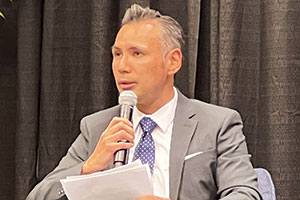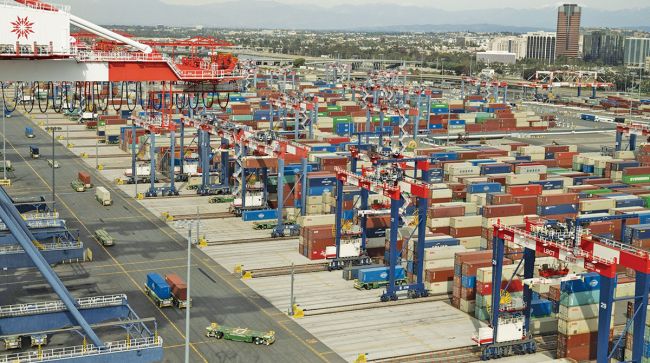LONG BEACH, Calif. — Facing a steady decline in freight, leaders at Port of Long Beach and adjacent Port of Los Angeles say they are using this time to retool and rebuild critical infrastructure and also market what they say are their many business advantages.
In an exclusive interview with Transport Topics at the annual IANA Intermodal Conference in Long Beach, Port of Long Beach Chief Operating Officer Noel Hacegaba said the port is down nearly 27% year-to-date compared with 2022’s pandemic-supercharged numbers. But he believes better days are ahead, and the next three months are forecast to show an uptick.
“It’s important to note that where we expect to land at the end of the year will be pretty much in line where we were in 2019 and a return to the pre-pandemic levels,” Hacegaba said. “It’s good to have that baseline; certainly I would have preferred for us to have sustained some of that momentum we had in 2021 and 2022.”
In 2019, the Port of Long Beach processed 7.6 million 20-foot-equivalent units, the fifth-busiest year in the port’s history.

Port of Long Beach Chief Operating Officer Noel Hacegaba. (Dan Ronan/Transport Topics)
Hacegaba acknowledges that contract negotiations that lasted more than a year and the ratification process between management’s Pacific Maritime Association and the 22,000-member International Longshore and Warehouse Union cost the West Coast ports a substantial amount of business as many shippers moved their cargo to ports on the East Coast and Gulf of Mexico. But now there is guaranteed labor peace, and he says his port and others are aggressively marketing their facilities to win back business.
“Now that we have a contract that’s ratified and inked, I am confident a lot of that diversion is going to come back,” he said.
Hacegaba noted as more U.S. companies consider moving some manufacturing back to North America from China, he believes the Pacific Ocean ports are in a strong position to acquire a big share of the shipping business because of their close proximity to Mexico and other Latin American nations.
#POLB saw a modest start to the traditional “peak” shipping season. Dockworkers and terminal operators moved 682,312 TEUs last month. While that’s down 15.4% from August 2022, it represents an 18% cargo increase over July 2023. https://t.co/CjhcIRywJtpic.twitter.com/Tui0tAYLuU
— Port of Long Beach (@portoflongbeach) September 13, 2023
“When 70% of your business is with one country, any time that country is going through some economic challenges or slowdowns it raises concerns. We learned that in 2018-2019 during the U.S.-China trade dispute,” he said. “We’ve also seen the pandemic accelerate the shift away from China and Southeast Asia, and we are seeing an increased business and interest from Mexico.
“We think Mexico could emerge in the future as a logistics hub, taking on some of that manufacturing and business that had been in China. Mexico is close to the U.S., and many retailers have been scared and burned by some of the recent disruptions in China.”
President Biden and Secretary General Nguyễn Phú Trọng announced a new Comprehensive Strategic Partnership between the U.S. and Vietnam – Vietnam’s highest tier of international partnership.
This weekend, @POTUS deepened the critical relationship between our two countries. pic.twitter.com/r6hFoCYiPF
— The White House (@WhiteHouse) September 11, 2023
During his recent trip to India for the G20 summit, President Joe Biden made a stop in Vietnam and met with officials in that nation. Hacegaba said that is an encouraging trend, and it could mean more business for Pacific ports.
“Vietnam has certainly emerged as nation in Southeast Asia that has demonstrated its ability to be a reliable manufacturing partner for many retailers, and I was there four years ago and I saw firsthand the potential it has,” Hacegaba said. “The trend that has been in motion for some time is a trend away from China. At some point, here in the U.S. we have to tap the alternative options to make sure we preserve our market share.”
Hacegaba said the Port of Long Beach is agnostic in terms of where cargo comes from.
The port also is in the midst of a 10-year, $2.2 billion capital improvement program, which is separate from the $4.5 billion the port has spent on infrastructure improvements since 2011.
Find out how #POLB is working to become the world’s first zero-emissions port at the Green Port Fair! Join us for free family fun. https://t.co/xsmTSRRfkB#GreenPortFair
Harry Bridges Memorial Park,
(next to the Queen Mary)
Saturday, October 7
⏱️ 11 a.m. – 4 p.m. pic.twitter.com/XhmOgsuOyV— Port of Long Beach (@portoflongbeach) September 12, 2023
Some of the money will be spent to comply with the California Air Resources Board requirements that all drayage trucks entering seaports and intermodal rail yards be zero emissions by 2035.
“This is where partnerships come in,” he said. “Our quest to a zero emissions is one we can only get there when we work together. The investments that the federal and state governments have been at historic levels will help us get there.”

Transport Topics’ Seth Clevenger, Michael Freeze and Mike Senatore dissect the new Top 100 list of the largest private carriers, including how fleets are adapting to this softened market. Tune in above or by going to RoadSigns.ttnews.com.
Hacegaba pointed to the nearly $400 million the Port of Long Beach was recently awarded to begin the transition to zero emissions.
Even with the challenges of the pandemic and the post-pandemic economic downturn, Hacegaba is optimistic.
“The reality is to the rest of the world the ports of Long Beach and Los Angeles are one complex. Each port will do what it must to grow their volume, and that’s the way it should be. The competition is healthy,” Hacegaba said. “We recognize what a massive economic engine the port is for our community, the state and the nation. And I think the stars are aligning when you look at the investments in infrastructure through the Infrastructure [Investment] and Jobs Act, the Inflation Reduction Act, and they’re all saying the same thing: We have to invest in our ports, and we have to enhance our competitiveness.”






